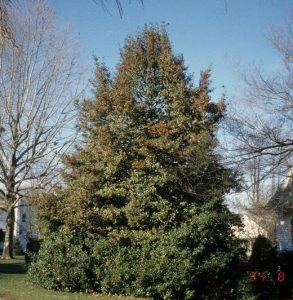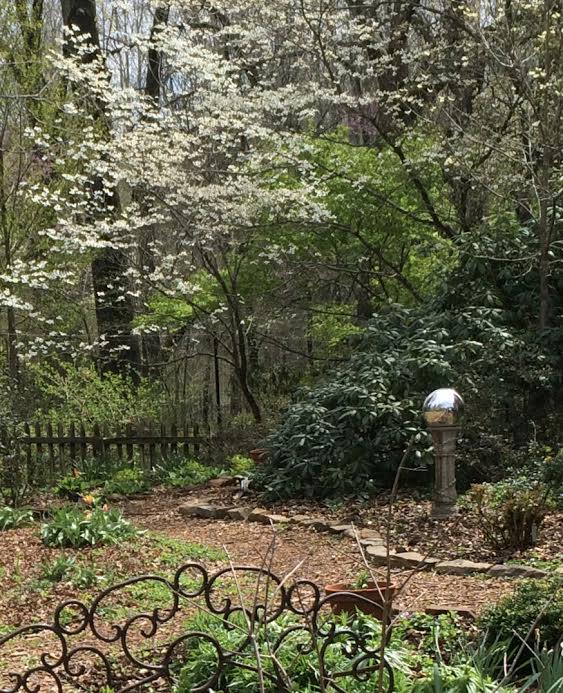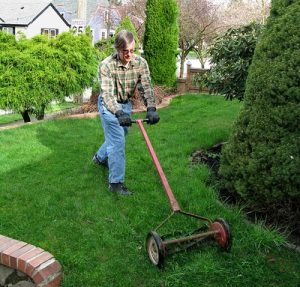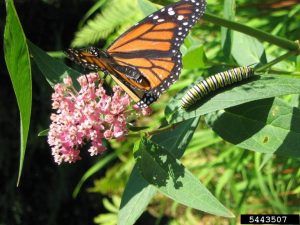I recently had the good fortune to hear a virtual presentation by Dr. Deborah Lawrence, a professor of environmental sciences at the University of Virginia, where she is serving as director of the Environmental Thought and Practice Program. Much of her research is focused on the links between tropical deforestation and climate change. One of her goals is to build community around climate action, and Dr. Lawrence believes gardeners can contribute mightily in the effort to combat climate change. Her recommendations are outlined below.
Protect and Expand Forests
Trees are made of carbon, and they absorb quite a bit of carbon dioxide, too. Stanford.edu. Deforestation contributes 12% of the total global greenhouse gas emissions. We gardeners can certainly aim to add more trees to our own properties, and we can encourage our neighbors to do the same. In addition, we can protect any forests near our homes. We tend to be keen observers, so let’s put those tendencies to work by monitoring our trees for signs of trouble, like pests, diseases, or choking invasive vines. Oriental bittersweet can swallow trees whole and kill them, so be vigilant and remove it early. For photo guidance in identifying tree disease, check Forestry Images.org/Diseases. If you would like to enhance your knowledge of diseases affecting oak trees, be sure to check out a recent Garden Shed article, What’s Killing our Oak Trees.

Planting new trees is a powerful way to help mitigate climate change. Proceedings of the National Academy of Sciences, Oct. 2020. You’ll definitely want to plant native trees, since they’ll do double duty — not only sequestering carbon, but also providing food for native bees, beneficial insects, and other wildlife hard hit by climate change. If you’re making a decision about which tree to plant, an excellent place to start is Piedmont Native Plants: a Guide for Landscapes and Gardens, formerly available only in book form, but now available online. This Guide is helpfully divided into two chapters on trees — short and tall. Another source is Common Native Trees of Virginia.
Remember that you can easily search prior issues of The Garden Shed for articles on trees of interest to you. You’ll find the “Search this site” function on the front page of each issue of The Garden Shed. Here are links to recent articles on native trees: For detailed information about maples, see Red Maple Earns its Popularity, The Garden Shed, and for our native white oak, see White Oak — A Majestic Native Species, The Garden Shed, for native hornbeam, see Consider a Hornbeam, The Garden Shed.
Dr. Lawrence also recommends that we avoid cutting large trees — which sequester large amounts of carbon — to the extent possible. This recommendation might be easier said than done; however, it has me rethinking some of my garden plans. For example, I’ve been planning to remove a native tree that is in the way of a hedge I’d like to create, but now I’m looking for ways to achieve my goal without chopping down a large tulip poplar.
Manage Yard Waste and Food Scraps to Avoid Methane Emissions
Dr. Lawrence urged us to manage our yard waste thoughtfully, or it could end up producing methane. I knew that methane was one of the “greenhouse gases” that trap heat near the Earth’s surface, but I learned that there’s plenty more to know about methane. Perhaps the most important thing to know is that “according to the Intergovernmental Panel on Climate Change (IPCC), methane is more than 20 times as effective as CO2 at trapping heat in the atmosphere.” Carbon, Methane Emissions and the Dairy Cow (Penn. St. Ext. 2016). Unfortunately, scientists are reporting major increases in methane in recent years.
Methane gas has both natural and man-made sources, and oil and gas operations are major emitters. But natural sources of methane? Well, we’ve all heard about the methane produced by cows, which scientists politely refer to as “enteric fermentation.” But, unfortunately, methane is often produced by the decomposition of biodegradable materials — like tree limbs and clippings from yards — in landfills. That’s because the decomposition process in landfills often occurs in the absence of oxygen — anaerobically — and that results in methane gas emissions. Happily, some landfills now have some method for managing the methane, but until that’s the case universally, we can all help out by diverting our yard waste from the landfill.
What’s the final resting place of our local yard waste? The City of Charlottesville does not offer curbside yard waste collection, nor does it accept yard waste in its composting drop-off programs. Albemarle County does not have a landfill, so trash haulers send trash to a transfer station, perhaps the Ivy Materials Utilization Center (MUC) or to another transfer station where trash is consolidated into larger trucks and then hauled to the Shoosmith Landfill in Chesterfield County or to another Virginia landfill. Albemarle County.org/Solid Waste & Recycling.

The good news is that if yard waste is delivered to the Ivy MUC, it is ground into mulch, which is then sold to the public. Ivy MUC Services and Fees/Disposal Charges/Rivanna.org. But what happens to the yard waste that is collected by the many private trash haulers in our area? That’s an important question, but it’s not easily answered. Looking at a particular hauler’s website has not been illuminating, at least in my research. The Albemarle County website has the following statement:
Some haulers use the County Waste Material Recovery Facility (MRF) co-located at the Shoosmith Landfill to sort their recyclables. The County does not oversee these services so encourages residents to ask their haulers about what recyclables they collect and what happens to them.
We gardeners can make inquiries of our private haulers, and we can make it clear that we do NOT want our yard trimmings and brush to end up in a landfill. Who knows what might happen if they are inundated with telephone calls?

Avoiding the landfill is perfectly do-able when you’re dealing with grass clippings and smaller trimmings. But does this mean I should be going in on a chipper/shredder with my neighbors? It might make sense on large properties that produce lots of yard waste, but that chipper/shredder is going to produce greenhouse gases, too. If your yard has an out-of-the-way area or adjoins a woods, what about making a pile of limbs and brush there as cover or habitat for birds, bees and other wildlife? Those tree limbs will decompose slowly and naturally, and this process does produce some carbon dioxide as part of the natural carbon cycle: i.e., plants remove carbon from the atmosphere for photosynthesis, the carbon moves among organisms through the foodweb, and is then released by decomposition. Still, from the standpoint of reducing greenhouse gas emissions, a brush pile in your yard is preferable to sending it to a landfill. And whatever you do, avoid burning your brush, since combustion produces carbon dioxide and other greenhouse gases.
Use Best Composting Practices
We gardeners know that composting is good, right? Well, it’s not that simple. Composting food scraps and clippings actually produces some greenhouse gases as part of that natural decomposition process mentioned above. This was news to me. And I was shocked to learn that methane is sometimes found at the bottom of compost piles because that’s where anaerobic conditions can occur. It turns out that my garden fork is an important weapon in reducing greenhouse gas emissions because aerating your pile helps prevent methane. Combine this with other good composting practices — balancing the carbon-to-nitrogen ratio and providing adequate moisture — and you will minimize greenhouse gas emissions.
Are you composting your paper towels? I have to admit that I had not been doing this until the pandemic rolled over my life. Then suddenly my family and I were doing way more handwashing, and in our efforts to be really clean, we were avoiding the cloth towels by the sink. I wasn’t comfortable with throwing all that paper into the garbage, so I did some research. The good news is that paper towels and napkins — even those that are food-soiled — should definitely go into your compost bin, unless they were used with harsh chemicals or have a lot of grease or oil attached. Backyard Composting, Va. Coop. Ext. It’s a good idea to shred or tear paper towels first. In fact, do the same with newspapers, paper bags and the like; most paper is safely compostable. Composting at home/Indiana Environmental Resilience Institute.
Make your Yard and Garden Part of the Solution

Another surprising thing I learned from Dr. Lawrence is that our plant choices can make a difference in mitigating climate change. When we choose ornamentals, the factors we usually consider are ease of culture, size, native status, flower color, pests, and the like. Dr. Lawrence would have us add another factor: how long can carbon be sequestered in this plant? The answer to this question favors perennials over annuals, and gives a major endorsement to shrubs and trees. This approach can be called a “climate victory garden.” Part of that garden should be for growing as much of our own food as possible, thus reducing the fossil fuel emissions entailed in the production and transportation of food grown in large agri-business operations.


Avoid combustion engines. Did you know that gas-powered yard tools cause 4% of carbon emissions? Rake your leaves; don’t blow them. Mow your yard with a push or electric mower. These tactics might strike some as burdensome — with relatively little benefit — but they can make a major impact if enough of us are willing to change.
Advocate for Climate Action
People who garden tend to be lovers of the earth; they are also quick to notice changes in whatever spot of earth they cultivate. These traits make gardeners well-suited to advocacy for climate action. Dr. Lawrence suggested involving ourselves with Climate Action Together, a program uniting Charlottesville, Albemarle County, and the University of Virginia in planning for and taking steps to achieve emission reductions. Find out more about this project and how you might assist at Climate Action Together/Advancing Climate Action in Charlottesville-Albemarle-UVA.
Become a Citizen-Scientist
If buds on dogwoods open earlier than usual, we gardeners are often the first to take notice. We can put our observational tendencies to work by monitoring and recording our observations, building data for researchers to mine for new insights into our changing climate. Here are a couple of citizen-science projects you might like to be part of:
Budburst/Chicago Botanic Garden: Volunteers observe and report on leafing, flowering, and fruiting of plants. The data is used by research scientists, educators, and horticulturists “to answer specific, timely, and critical ecological research questions. These observations are used to better understand how plant species and ecosystems respond to changes in climate locally, regionally, and nationally.” In addition to this project, the Chicago Botanic Garden sponsors other citizen-science projects. You may want to look at the entire list, Project List/Budburst, but the following may be of particular interest:
- Cherry Blossom Blitz: Observe and report on blossoming of cherry trees near you.
- Nativars Research Project: Participants observe and report on pollinator visits to five species of natives and cultivars in their yards to help scientists answer this question: “Do nativars provide the same resources for pollinators as their wild cousins?” This project runs through the fall of 2022, so there’s time to add some of the target plants to your garden or to containers on a porch or patio. For detailed coverage of the natives vs. nativar issue, see Native Species or Cultivars of Native Plants — Does it Matter? / The Garden Shed.
Audubon Climate Watch: By observing birds in your area, using a specific protocol, you can assist scientists studying how climate change is affecting birds. To see an article that used citizen-gathered data, check here: Audubon.org. The next survey will take place January 15 – February 15, 2021, and is open to the public. Find out more here: How to Join Climate Watch.
Caterpillars Count!: Participants survey shrubs and trees for caterpillars and other arthropods, and the data is used to determine periods of abundance, and to what extent climate change is affecting their populations. This project is sponsored by the University of North Carolina and is part of the nationwide Pheno Mismatch project funded by the National Science Foundation. These scientists are studying phenological mismatch, a possible result of climate change. For example, if a plant species blooms earlier than prior years, but the pollinators that feed on and pollinate this flower do not arrive or grow earlier as well, then a phenological mismatch has occurred; as a result of this mismatch, the plant population declines, and the pollinators must find other sources of food.

Monarch Model Validation Project/Univ. of Maine Cooperative Fish & Wildlife Research Unit: Observe and report monarch butterfly migration stopover habitats.
Monarch Watch: Volunteers track the number of monarchs seen in their yards during spring and fall breeding periods. The data will be used by scientists seeking “to identify critical factors that explain the inter-annual variation” in monarch numbers. The observation periods for 2021 begin in March for those in the South, and in April for residents of the North. Find out more about this project and how to register here: Monarch Watch/calendar, registration and recording.
For those of us who love and care for plants, it’s easy to sink into hopelessness as we watch how climate change is advancing. But there are things we can do, and gardeners are nothing if not doers. As we plan for spring gardening, let’s plan also to accomplish as many of Dr. Lawrence’s recommendations as possible.
SOURCES:
“Tree planting has the potential to increase carbon sequestration capacity of forests in the United States,” PNAS.org/Brief Report/Proceedings of the National Academy of Sciences (2020)
“How much longer will trees absorb carbon dioxide?” Stanford Univ.edu
“National Emissions from Lawn and Garden Equipment,” www.epa.gov (2019)
“Your Yard Is a Stealthy Fossil Fuel Guzzler—Give It a Climate Makeover: Lose the fertilizers, power tools, and water-hogging plants, and you’ll have a much greener garden. Here’s how,” www.audubon.org
“Investigation on greenhouse gas emissions and compost dynamics during in-vessel co-composting of septage and mixed organic wastes,” Int. Journal of Environmental Science & Technology, 17, 1675 (Thomas, A.R., Arulraj, P.R., Kranert, M. et al. 2020), link.springer.com
Methane: The other important greenhouse gas/Environmental Defense Fund
Connections: Compost and Methane Avoidance,” Biocycle.net (Sally Brown, research professor, College of the Environment, University of Washington)
“Methane Avoidance From Composting” Issue Paper/Washington.edu, (SAIC, Climate Action Reserve, 2009)
“Greenhouse gas emission effect of suspending slash pile burning in Ontario’s managed forests,” The Forestry Chronicle, Vol. 92, No. 3 (2016) https://pubs.cif-ifc.org/doi/pdf/10.5558/tfc2016-061
Small Scale or Backyard Composting/Cornell Waste Management Institute (includes extensive list of resources)
The Virginia Yard-Waste Management Manual, (2d ed. Va.Tech)
Regenerative Gardening: Growing Food Successfully & Sustainably in a Changing Climate (video, July 2020, Dr. Sarah Via, Professor & Climate Extension Specialist, Univ. of Maryland)